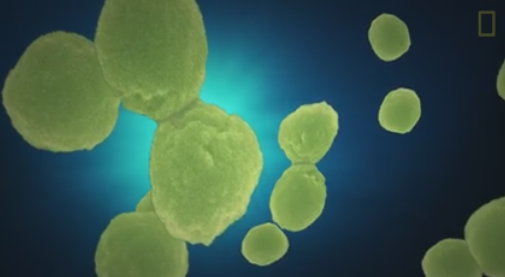File:Planktonbluegreen tinyones.jpg: Difference between revisions
Siterunner (talk | contribs) (Category:Biodiversity Category:Citizen Science Category:Climate Change Category:Climate Policy Category:Earth Observations Category:Earth Science Category:Earth360 Category:Ecology Studies Category:Ecoregions [[Categ...) |
Siterunner (talk | contribs) No edit summary |
||
| Line 1: | Line 1: | ||
<big>'''Types of Plankton'''</big> | |||
https://en.wikipedia.org/wiki/Plankton | |||
Plankton organisms include drifting or floating bacteria, archaea, algae, protozoa and animals that inhabit, for example, the pelagic zone of oceans, seas, or bodies of fresh water. Essentially, plankton are defined by their ecological niche rather than any phylogenetic or taxonomic classification... | |||
'''Oxygen production''' | |||
Phytoplankton absorb energy from the Sun and nutrients from the water to produce their own food. In the process of photosynthesis, phytoplankton release molecular oxygen (O2) into the water. It is estimated that between 50% — 85% of the world's oxygen is produced via phytoplankton photosynthesis. The rest is produced via photosynthesis on land by plants. Furthermore, phytoplankton photosynthesis has controlled the atmospheric CO2/O2 balance since the early Precambrian Eon. | |||
'''Prochlorocossus''' | |||
[[File:Prochlorococcus blue-green.tiny ones.png]] | |||
'''Zooplankton''' | |||
https://en.wikipedia.org/wiki/Zooplankton | |||
'''Phytoplankton''' | |||
https://en.wikipedia.org/wiki/Phytoplankton | |||
https://upload.wikimedia.org/wikipedia/commons/thumb/d/da/Phytopla.jpg/220px-Phytopla.jpg | |||
[[Category:Biodiversity]] | [[Category:Biodiversity]] | ||
[[Category:Citizen Science]] | [[Category:Citizen Science]] | ||
Revision as of 15:29, 2 May 2016
Types of Plankton
https://en.wikipedia.org/wiki/Plankton
Plankton organisms include drifting or floating bacteria, archaea, algae, protozoa and animals that inhabit, for example, the pelagic zone of oceans, seas, or bodies of fresh water. Essentially, plankton are defined by their ecological niche rather than any phylogenetic or taxonomic classification...
Oxygen production
Phytoplankton absorb energy from the Sun and nutrients from the water to produce their own food. In the process of photosynthesis, phytoplankton release molecular oxygen (O2) into the water. It is estimated that between 50% — 85% of the world's oxygen is produced via phytoplankton photosynthesis. The rest is produced via photosynthesis on land by plants. Furthermore, phytoplankton photosynthesis has controlled the atmospheric CO2/O2 balance since the early Precambrian Eon.
Prochlorocossus
Zooplankton
https://en.wikipedia.org/wiki/Zooplankton
Phytoplankton
https://en.wikipedia.org/wiki/Phytoplankton
https://upload.wikimedia.org/wikipedia/commons/thumb/d/da/Phytopla.jpg/220px-Phytopla.jpg
File history
Click on a date/time to view the file as it appeared at that time.
| Date/Time | Thumbnail | Dimensions | User | Comment | |
|---|---|---|---|---|---|
| current | 20:28, 18 February 2016 |  | 640 × 320 (99 KB) | Siterunner (talk | contribs) | Category:Biodiversity Category:Citizen Science Category:Climate Change Category:Climate Policy Category:Earth Observations Category:Earth Science Category:Earth360 Category:Ecology Studies Category:Ecoregions [[Categ... |
You cannot overwrite this file.
File usage
- Biodiversity
- Citizen Science
- Climate Change
- Climate Policy
- Earth Observations
- Earth Science
- Earth360
- Ecology Studies
- Ecoregions
- Environmental Security
- Extinction
- Fisheries
- Green Graphics
- Oceans
- Ocean Ecosystem
- Ocean Science
- Ocean Sustainability
- Planet Citizen
- Planet Scientist
- Planet Citizens, Planet Scientists
- Whole Earth
